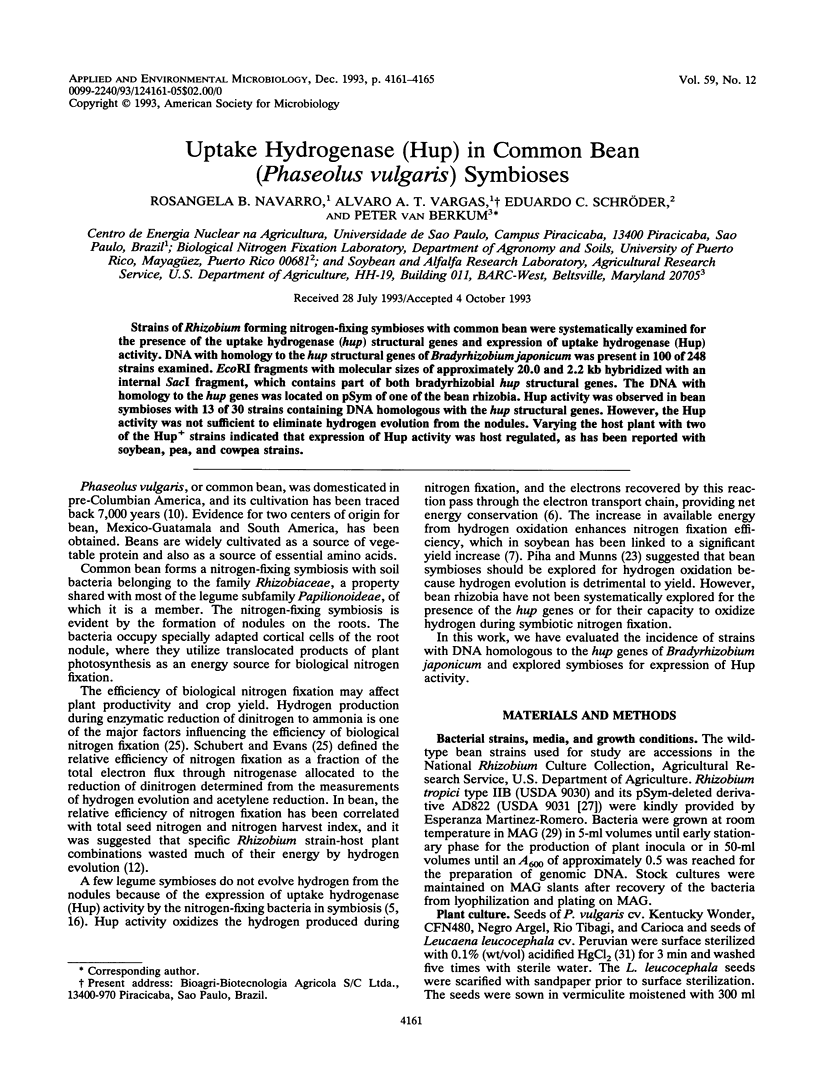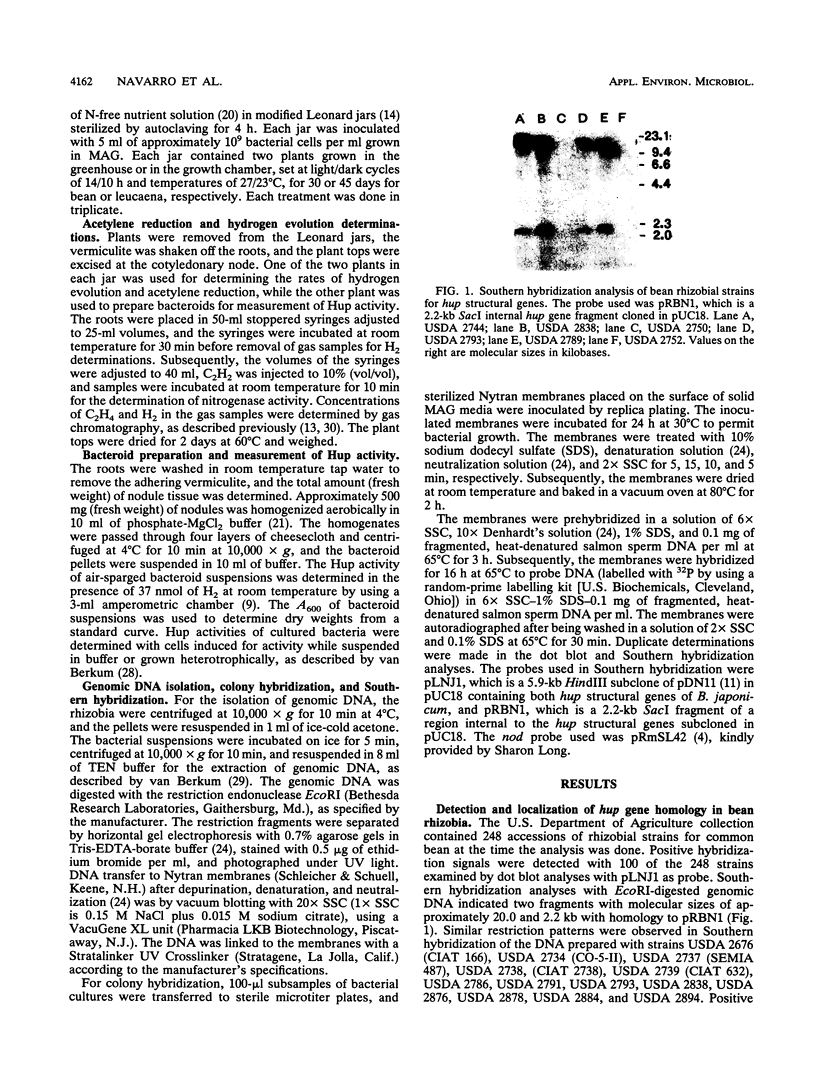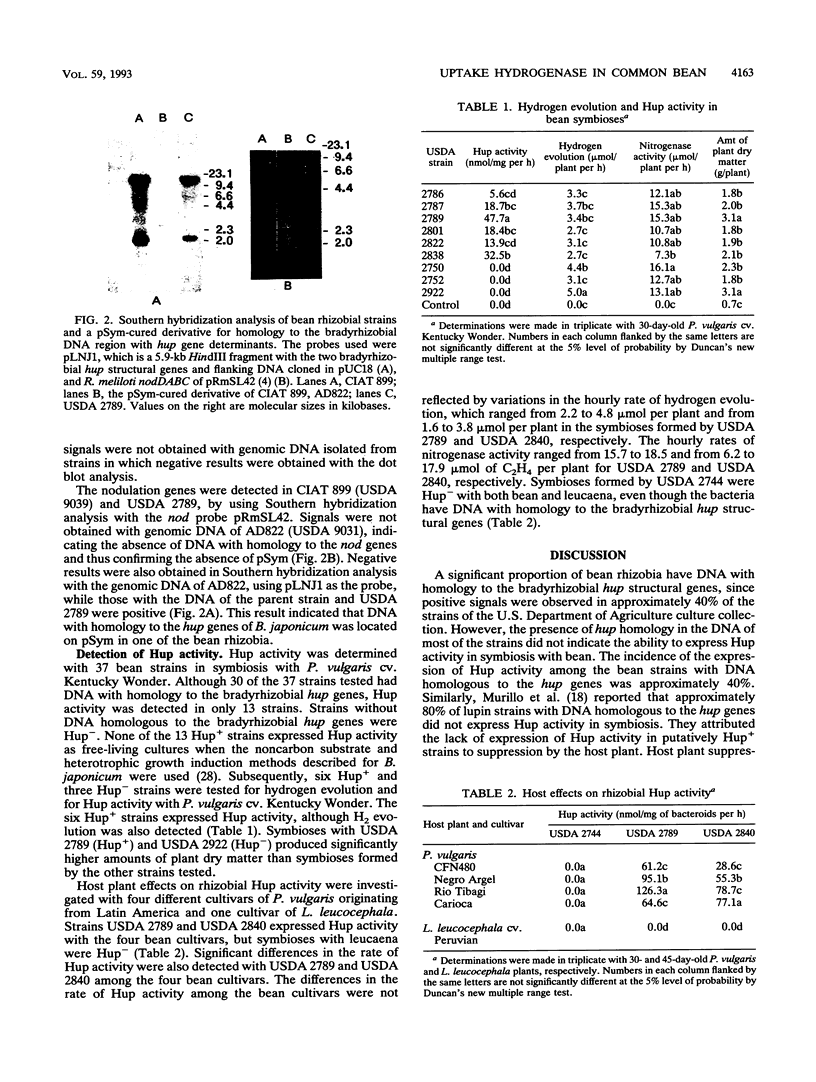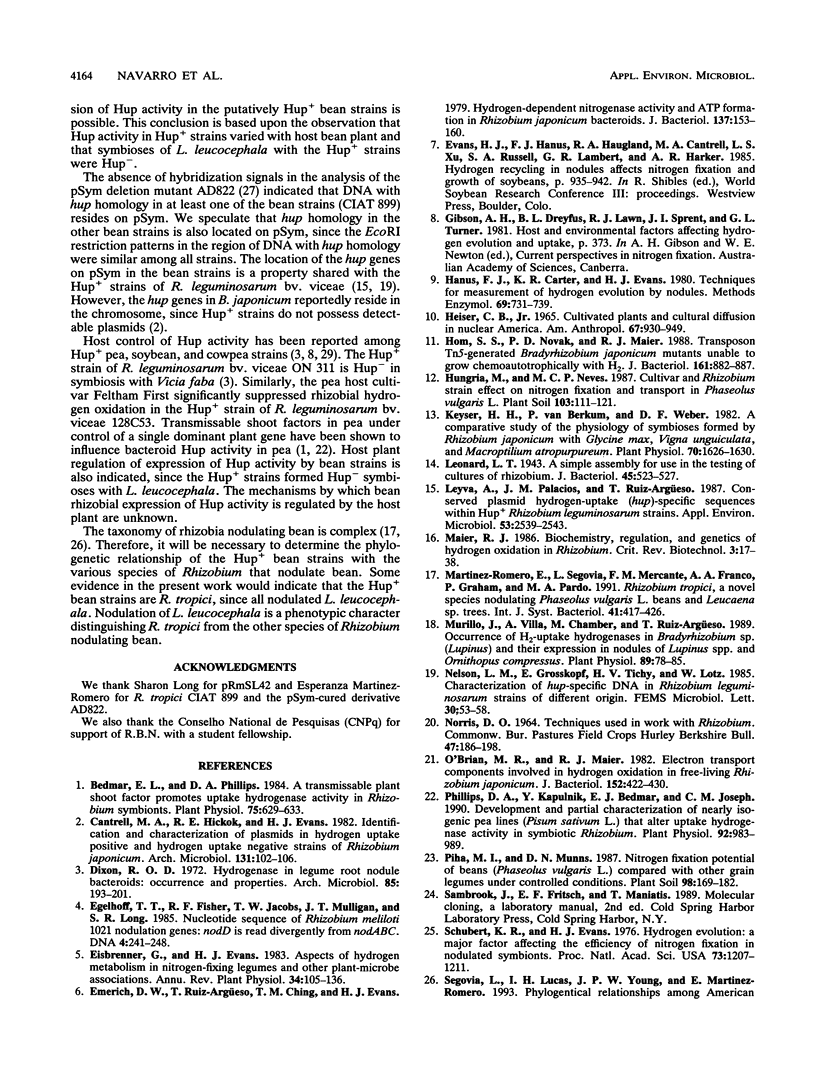Abstract
Strains of Rhizobium forming nitrogen-fixing symbioses with common bean were systematically examined for the presence of the uptake hydrogenase (hup) structural genes and expression of uptake hydrogenase (Hup) activity. DNA with homology to the hup structural genes of Bradyrhizobium japonicum was present in 100 of 248 strains examined. EcoRI fragments with molecular sizes of approximately 20.0 and 2.2 kb hybridized with an internal SacI fragment, which contains part of both bradyrhizobial hup structural genes. The DNA with homology to the hup genes was located on pSym of one of the bean rhizobia. Hup activity was observed in bean symbioses with 13 of 30 strains containing DNA homologous with the hup structural genes. However, the Hup activity was not sufficient to eliminate hydrogen evolution from the nodules. Varying the host plant with two of the Hup+ strains indicated that expression of Hup activity was host regulated, as has been reported with soybean, pea, and cowpea strains.
Full text
PDF




Images in this article
Selected References
These references are in PubMed. This may not be the complete list of references from this article.
- Bedmar E. J., Phillips D. A. A transmissible plant shoot factor promotes uptake hydrogenase activity in Rhizobium symbionts. Plant Physiol. 1984 Jul;75(3):629–633. doi: 10.1104/pp.75.3.629. [DOI] [PMC free article] [PubMed] [Google Scholar]
- Dixon R. O. Hydrogenase in legume root nodule bacteroids: occurrence and properties. Arch Mikrobiol. 1972;85(3):193–201. doi: 10.1007/BF00408844. [DOI] [PubMed] [Google Scholar]
- Egelhoff T. T., Fisher R. F., Jacobs T. W., Mulligan J. T., Long S. R. Nucleotide sequence of Rhizobium meliloti 1021 nodulation genes: nodD is read divergently from nodABC. DNA. 1985 Jun;4(3):241–248. doi: 10.1089/dna.1985.4.241. [DOI] [PubMed] [Google Scholar]
- Emerich D. W., Ruiz-Argüeso T., Ching T. M., Evans H. J. Hydrogen-dependent nitrogenase activity and ATP formation in Rhizobium japonicum bacteroids. J Bacteriol. 1979 Jan;137(1):153–160. doi: 10.1128/jb.137.1.153-160.1979. [DOI] [PMC free article] [PubMed] [Google Scholar]
- Hom S. S., Graham L. A., Maier R. J. Isolation of genes (nif/hup cosmids) involved in hydrogenase and nitrogenase activities in Rhizobium japonicum. J Bacteriol. 1985 Mar;161(3):882–887. doi: 10.1128/jb.161.3.882-887.1985. [DOI] [PMC free article] [PubMed] [Google Scholar]
- Keyser H. H., van Berkum P., Weber D. F. A Comparative Study of the Physiology of Symbioses Formed by Rhizobium japonicum with Glycine max, Vigna unguiculata, and Macroptilium atropurpurem. Plant Physiol. 1982 Dec;70(6):1626–1630. doi: 10.1104/pp.70.6.1626. [DOI] [PMC free article] [PubMed] [Google Scholar]
- Leonard L. T. A Simple Assembly for Use in the Testing of Cultures of Rhizobia. J Bacteriol. 1943 Jun;45(6):523–527. doi: 10.1128/jb.45.6.523-527.1943. [DOI] [PMC free article] [PubMed] [Google Scholar]
- Leyva A., Palacios J. M., Ruiz-Argüeso T. Conserved Plasmid Hydrogen-Uptake (hup)-Specific Sequences within HupRhizobium leguminosarum Strains. Appl Environ Microbiol. 1987 Oct;53(10):2539–2543. doi: 10.1128/aem.53.10.2539-2543.1987. [DOI] [PMC free article] [PubMed] [Google Scholar]
- Martínez-Romero E., Segovia L., Mercante F. M., Franco A. A., Graham P., Pardo M. A. Rhizobium tropici, a novel species nodulating Phaseolus vulgaris L. beans and Leucaena sp. trees. Int J Syst Bacteriol. 1991 Jul;41(3):417–426. doi: 10.1099/00207713-41-3-417. [DOI] [PubMed] [Google Scholar]
- Murillo J., Villa A., Chamber M., Ruiz-Argüeso T. Occurrence of H(2)-Uptake Hydrogenases in Bradyrhizobium sp. (Lupinus) and Their Expression in Nodules of Lupinus spp. and Ornithopus compressus. Plant Physiol. 1989 Jan;89(1):78–85. doi: 10.1104/pp.89.1.78. [DOI] [PMC free article] [PubMed] [Google Scholar]
- O'Brian M. R., Maier R. J. Electron transport components involved in hydrogen oxidation in free-living Rhizobium japonicum. J Bacteriol. 1982 Oct;152(1):422–430. doi: 10.1128/jb.152.1.422-430.1982. [DOI] [PMC free article] [PubMed] [Google Scholar]
- Phillips D. A., Kapulnik Y., Bedmar E. J., Joseph C. M. Development and Partial Characterization of Nearly Isogenic Pea Lines (Pisum sativum L.) that Alter Uptake Hydrogenase Activity in Symbiotic Rhizobium. Plant Physiol. 1990 Apr;92(4):983–989. doi: 10.1104/pp.92.4.983. [DOI] [PMC free article] [PubMed] [Google Scholar]
- Schubert K. R., Evans H. J. Hydrogen evolution: A major factor affecting the efficiency of nitrogen fixation in nodulated symbionts. Proc Natl Acad Sci U S A. 1976 Apr;73(4):1207–1211. doi: 10.1073/pnas.73.4.1207. [DOI] [PMC free article] [PubMed] [Google Scholar]
- Segovia L., Piñero D., Palacios R., Martínez-Romero E. Genetic structure of a soil population of nonsymbiotic Rhizobium leguminosarum. Appl Environ Microbiol. 1991 Feb;57(2):426–433. doi: 10.1128/aem.57.2.426-433.1991. [DOI] [PMC free article] [PubMed] [Google Scholar]
- van Berkum P. Evidence for a Third Uptake Hydrogenase Phenotype among the Soybean Bradyrhizobia. Appl Environ Microbiol. 1990 Dec;56(12):3835–3841. doi: 10.1128/aem.56.12.3835-3841.1990. [DOI] [PMC free article] [PubMed] [Google Scholar]
- van Berkum P. Expression of uptake hydrogenase and hydrogen oxidation during heterotrophic growth of Bradyrhizobium japonicum. J Bacteriol. 1987 Oct;169(10):4565–4569. doi: 10.1128/jb.169.10.4565-4569.1987. [DOI] [PMC free article] [PubMed] [Google Scholar]
- van Berkum P., Sloger C. Immediate acetylene reduction by excised grass roots not previously preincubated at low oxygen tensions. Plant Physiol. 1979 Nov;64(5):739–743. doi: 10.1104/pp.64.5.739. [DOI] [PMC free article] [PubMed] [Google Scholar]




